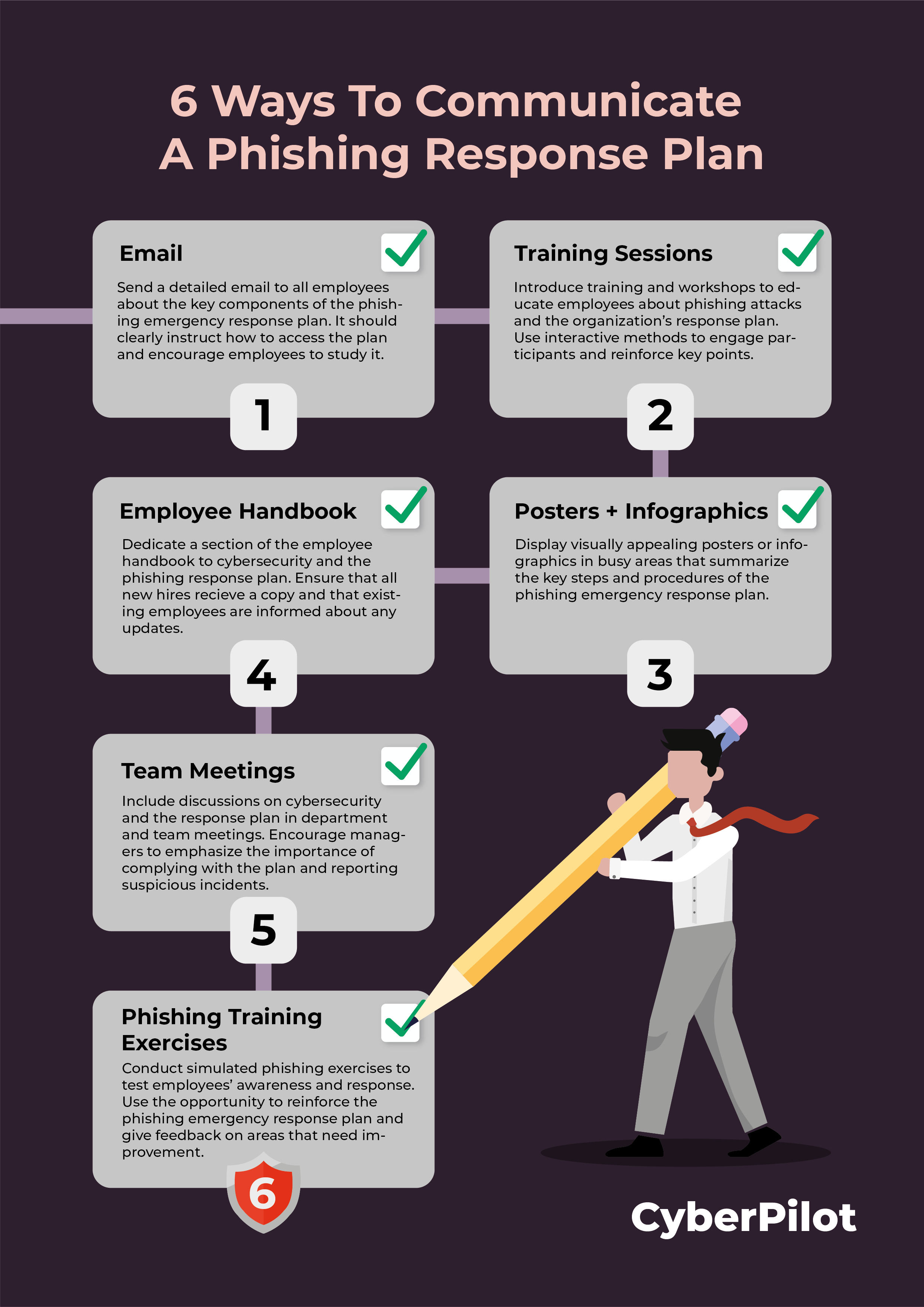Organizations face an ongoing battle against the persistent threat of phishing attacks. Safeguarding sensitive information and minimizing the impact of these malicious schemes requires a robust and well-prepared phishing emergency response plan. In this blog post, we will first explore the vital components that make up a comprehensive phishing response plan and then we will share some general steps that employees can follow when faced with a phishing attack. By understanding and implementing the key elements of the response plan, your organization can enhance its readiness to tackle phishing incidents head-on.
What is an emergency phishing response plan?
An emergency phishing response plan is a documented strategy and set of procedures that your organization can put in place to address and mitigate the impact of phishing attacks. The plan serves as a blueprint for your organization's response to phishing attacks, ensuring a coordinated and effective approach to handle incidents promptly. It defines roles and responsibilities, establishes communication channels, and provides guidelines for employees to follow. The primary goal of an emergency phishing response plan is to minimize the impact of phishing attacks on an organization's security, finances, reputation, and data integrity.
Why do you need to write an emergency phishing response plan?
Creating an emergency phishing response plan is crucial for companies due to the rising threat of phishing attacks. Here are the key reasons why it’s important:
Mitigating Financial and Reputational Damage
Phishing attacks can result in significant financial losses through unauthorized access to accounts, fraudulent transactions, or ransom payments. A well-designed response plan helps mitigate these financial risks. Effective handling of phishing incidents also protects an organization's reputation by demonstrating a proactive approach to cybersecurity and maintaining trust among customers, partners, and stakeholders.
Minimizing Data Breach Risks
Phishing attacks often aim to gain access to sensitive data, such as login credentials, financial information, or intellectual property. A response plan ensures swift action to contain incidents, reducing the risk of data breaches and unauthorized data access or exposure.
Coordinated Team Efforts
An emergency response plan ensures that the right individuals and departments are involved in incident response efforts. It establishes clear roles and responsibilities, enabling effective coordination and collaboration among team members, IT personnel, security teams, and other stakeholders.
Employee Awareness and Preparedness
By incorporating training and awareness initiatives into the response plan, employees become more knowledgeable about phishing risks, detection techniques, and incident reporting procedures. This empowers them to actively contribute to the organization's defense against phishing attacks.
Continuous Improvement
A well-designed response plan allows organizations to learn from past incidents, identify weaknesses or gaps in security measures, and implement necessary improvements. Regular plan reviews and updates ensure that the organization stays resilient against evolving phishing tactics. Read our blogpost to learn more about how you can strengthen your IT security using the Plan Do Act Cycle.
How to write an emergency phishing response plan
Now that we’ve covered the what and why, let's talk about the how. Creating an effective emergency phishing response plan involves several key steps. Here is our comprehensive guide on how you can develop such a plan:
Assess Current Security Measures
The first step is to evaluate existing security protocols, technologies, and incident response capabilities to identify strengths and weaknesses. Determine if any specific vulnerabilities or gaps exist in relation to phishing attacks.
Establish a Cross-Functional Team
The next thing to do would be to form a dedicated team comprising IT, security, legal, HR, and communication professionals. Assign clear roles and responsibilities for each team member to ensure effective coordination during phishing incidents.
Identify Potential Phishing Scenarios
Now you should analyze historical data and industry trends to identify common phishing attack vectors targeting your organization. Consider different attack types, such as email phishing, spear phishing, and social engineering, to cover a wide range of scenarios.
Define Incident Response Procedures
Next you should develop clear and documented procedures for reporting phishing incidents internally. Determine the escalation path and establish communication channels with the IT or security team for incident response.
Rapid Response and Containment
Once the procedures have been defined you should work on outlining the immediate actions to be taken upon detecting a phishing incident, including disconnecting affected systems and isolating compromised accounts. Make sure to document steps to limit the spread of the attack and prevent further damage or unauthorized access.
Investigation and analysis
It's important that you define processes for investigating phishing incidents, including preserving evidence, analyzing email headers, and identifying the source of the attack. Establish protocols for determining the scope of the incident and assessing the potential impact on sensitive data and systems.
Incident Communication
Work on developing guidelines for internal and external communication during a phishing incident. Prepare templates or drafts of communication materials, including incident notifications, updates, and instructions for employees and stakeholders.
Employee Training and Awareness
One of the most important steps is to implement ongoing phishing and awareness training programs to educate employees about the risks, detection, and reporting of phishing attacks. Regularly communicate best practices for email security and emphasize the importance of employee vigilance.
Continuous Improvement and Evaluation
To make sure your company gets the most out of your emergency response plan, it's vital that you conduct regular reviews and drills to test the effectiveness of the response plan. Collect feedback from incident response activities and update the plan accordingly to address any identified weaknesses or emerging threats.
Documentation and Maintenance
Finally document the complete phishing response plan, including procedures, contact information, and incident response checklists. Regularly review and update the plan to reflect changes in technology, attack trends, or organizational structure.
By following these steps, organizations can create a robust emergency phishing response plan that enables them to respond swiftly and effectively to phishing incidents, minimizing potential damage and protecting sensitive information.
How to effectively communicate the phishing response plan
Effective communication of the phishing response plan is vital for creating a proactive and resilient defense against phishing attacks. It empowers employees to be active participants in cybersecurity and helps the organization protect its assets, reputation, and data from potential harm.

You can communicate the emergency phishing plan to employees through a number of channels. Here are some effective ways to communicate the plan:
-
Email
Send a detailed email to all employees, outlining the key components of the phishing emergency response plan. Provide clear instructions on how to access the full plan and emphasize the importance of reading and familiarizing themselves with its contents.
-
Training Sessions
Conduct training sessions or workshops dedicated to educating employees about phishing attacks and the organization's response plan. Use interactive methods to engage participants and reinforce key points.
-
Posters and Infographics
Create visually appealing posters or infographics summarizing the key steps and procedures of the phishing emergency response plan. Display them in prominent areas such as break rooms, hallways, or common areas.
-
Employee Handbook
Include a section dedicated to cybersecurity and the emergency phishing response plan in the company's employee handbook. Ensure that all new hires receive a copy and that existing employees are informed about any updates.
-
Team Meetings
Incorporate discussions on cybersecurity and the response plan into team meetings or departmental gatherings. Encourage managers and team leaders to emphasize the importance of following the plan and reporting any suspicious incidents.
-
Phishing training Exercises
Conduct simulated phishing exercises to test employees' awareness and response to potential phishing attacks. Use these exercises as opportunities to reinforce the emergency response plan and provide feedback on areas that need improvement.
Remember to use clear and straightforward language when communicating the plan to ensure that employees understand their roles and responsibilities. Regular reinforcement of the plan and continuous training are essential to maintaining a vigilant and prepared workforce.
Best Practices for Responding to Phishing Attacks
Knowing how to respond effectively to a phishing incident is crucial. We have come up with a short list that you can share with your employees. If an employee receives an email, they suspects might be a phishing attempt, they should follow the advice below:
- Do not open it. Avoid opening suspicious emails as in some cases, opening the email may cause you to compromise the security of your personal data.
- Report the email with the built-in reporting button in your email program.
- Do not download any attachments accompanying the message as they may contain malware.
- Never click links that appear in the message to avoid fraudulent websites.
- Do not reply to the sender. Ignore any requests the sender may solicit.
- Report the phishing attempt to your nearest leader and to your IT department to help others avoid falling victim.
A robust phishing emergency response plan is the cornerstone of your organization's cybersecurity strategy. By integrating incident reporting, rapid response, employee communication, system protection, and continuous improvement, you strengthen your defense against phishing attacks. With these essential elements in place, your organization gains the power to respond effectively to phishing incidents, minimize risks, and safeguard sensitive information.


